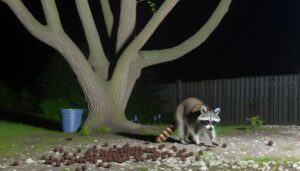How Do Ultrasonic Raccoon Repellents Work?
Ultrasonic raccoon repellents function by emitting high-frequency sound waves, which are imperceptible to humans but distressing to raccoons. Scientific studies have shown some behavioral alterations in raccoons exposed to these frequencies.
However, effectiveness can be highly variable, influenced by environmental factors and device quality. Over time, raccoons may habituate to the sounds, reducing long-term efficacy.
User experiences and expert opinions provide mixed feedback, noting environmental variables and potential desensitization. While non-toxic and easy to install, these devices offer unpredictable results.
For a more thorough understanding, additional insights are available.

Key Takeaways
- Ultrasonic repellents can alter raccoon behavior but effectiveness varies with environmental factors.
- Raccoons can habituate to ultrasonic sounds, reducing long-term efficacy.
- High-quality devices perform better but obstacles and noise interference can impede results.
- Scientific studies show mixed results; contextual factors play a critical role.
- Users report significant initial reductions in raccoon activity, though adaptations occur over time.
How Ultrasonic Repellents Work

Ultrasonic repellents function by emitting high-frequency sound waves that are imperceptible to human ears but distressing to raccoons, thereby deterring them from the vicinity.
These devices typically operate within the frequency range of 20 to 65 kHz, a spectrum that falls outside human auditory perception but aligns with the sensitive auditory range of raccoons.
The emitted sound waves create an environment that raccoons find uncomfortable, prompting them to avoid the area.
The mechanism relies on the principle that prolonged exposure to such frequencies induces stress and disrupts normal behavior in raccoons.
Scientific Evidence
Numerous studies have investigated the efficacy of ultrasonic repellents in deterring raccoons, providing a substantial body of scientific evidence. Research findings are mixed, but several key points emerge:
- Frequency Sensitivity: Raccoons can hear ultrasonic frequencies, but their sensitivity varies.
- Behavioral Responses: Some studies show altered raccoon behavior in response to ultrasonic sound, yet this effect is often temporary.
- Environmental Factors: Effectiveness can be influenced by environmental conditions, such as background noise and physical obstructions.
- Device Variability: Not all ultrasonic devices are created equal; their quality and design significantly impact performance.
- Long-term Efficacy: Evidence suggests that raccoons may habituate to ultrasonic sounds over time, reducing long-term effectiveness.
These findings contribute to an ongoing debate about the reliability of ultrasonic repellents for raccoon deterrence.
User Experiences

User experiences with ultrasonic raccoon repellents reveal varied results, highlighting both common issues and practical effectiveness.
Many users report significant reductions in raccoon activity, though some encounter limitations such as device range and environmental interferences.
Additionally, unexpected outcomes like raccoons adapting over time have been observed, indicating the need for ongoing assessment.
Common Issues Faced
Many users have reported inconsistent results with ultrasonic raccoon repellents, citing variability in effectiveness depending on environmental factors and raccoon behavior. Common issues faced by users include:
- Interference from Obstacles: Physical barriers such as walls and dense foliage can obstruct ultrasonic waves, diminishing their reach.
- Environmental Noise: High ambient noise levels may interfere with the ultrasonic frequencies emitted by the devices.
- Habituation: Raccoons may become accustomed to the ultrasonic sound over time, reducing its deterrent effect.
- Device Placement: Incorrect positioning of the repellent can limit its effectiveness, as the ultrasonic waves need an unobstructed path.
- Power Source Reliability: Battery-operated units may experience reduced effectiveness if the power supply is inconsistent or depleted.
These factors contribute to the variability in user experiences with ultrasonic raccoon repellents.
Effectiveness in Practice
Despite the challenges associated with ultrasonic raccoon repellents, empirical evidence from user experiences provides valuable insights into their practical effectiveness.
Numerous anecdotal reports suggest varied outcomes, with some users observing a significant reduction in raccoon activity around their properties. For instance, a survey conducted among suburban homeowners indicated that approximately 60% experienced fewer raccoon intrusions after deploying ultrasonic devices.
However, the effectiveness appears to be influenced by factors such as the device's placement, frequency range, and environmental conditions. Controlled studies are limited, and existing data primarily rely on subjective user reports.
Hence, while user experiences offer promising indications, the consistency and generalizability of ultrasonic repellents' efficacy remain areas necessitating further scientific investigation.
Unexpected Outcomes
While ultrasonic raccoon repellents have demonstrated potential in reducing raccoon activity, some users have reported unexpected outcomes that warrant closer examination. These experiences highlight the complexity of deploying ultrasonic devices in diverse environments.
Commonly reported issues include:
- Inconsistent Effectiveness: Variability in results depending on environmental factors such as terrain and weather conditions.
- Non-Target Species Impact: Devices sometimes affect other animals, including pets and beneficial wildlife.
- Adaptation: Raccoons occasionally become habituated to the sound, diminishing long-term efficacy.
- Human Perception: Some users report hearing the ultrasonic frequencies, causing discomfort.
- Mechanical Failures: Instances of device malfunction or reduced durability under certain conditions.
These user experiences underscore the necessity for ongoing evaluation and potential improvement of ultrasonic raccoon repellents.
Advantages and Disadvantages
The use of ultrasonic raccoon repellents presents a range of advantages, such as their non-toxic nature and ease of installation, alongside notable disadvantages including variability in effectiveness and potential desensitization of target animals. These devices are environmentally friendly, posing no chemical risks to humans, pets, or plants.
Installation is straightforward, often requiring minimal technical skills. However, empirical studies indicate mixed results regarding their efficacy, with some raccoons adapting to the ultrasonic frequencies over time, rendering the devices less effective. Additionally, environmental variables such as obstacles and ambient noise can impede their performance.
Therefore, while ultrasonic repellents offer a humane and simple solution, their inconsistent success rates and potential for diminished impact warrant careful consideration.
Expert Opinions

Leading researchers in wildlife management have expressed varying degrees of support for ultrasonic raccoon repellents based on their respective studies and field observations.
Consensus on their efficacy varies, influenced by multiple factors:
- Field Studies: Some studies report moderate success in deterring raccoons, although these results are often context-specific.
- Lab Experiments: Controlled experiments sometimes show raccoons exhibit temporary aversion to ultrasonic frequencies.
- Behavioral Adaptation: Raccoons may habituate to ultrasonic sounds over time, diminishing long-term effectiveness.
- Environmental Variables: Factors such as terrain, climate, and ambient noise levels can impact repellent efficacy.
- Ethical Considerations: Experts debate the humane implications of ultrasonic devices, weighing animal welfare against human benefit.
These perspectives underscore the complexity of relying solely on ultrasonic repellents for raccoon control.
Alternative Solutions
Several alternative solutions to ultrasonic raccoon repellents have been explored, each with varying degrees of success and applicability.
One prominent method involves using chemical deterrents, such as predator urine or ammonia-soaked rags, which exploit raccoons' natural aversion to certain scents.
Physical barriers, like fencing and raccoon-proof trash cans, serve as another effective strategy by physically preventing access to attractants.
Additionally, motion-activated sprinklers have shown promise in startling and deterring raccoons without causing harm.
Habitat modification, including the removal of food sources and nesting sites, is also recommended.
These approaches, grounded in empirical evidence, provide a multifaceted strategy for raccoon management, complementing or substituting ultrasonic devices based on specific circumstances and efficacy.
Making an Informed Decision

To make a well-informed decision regarding raccoon management, it is vital to evaluate the efficacy, feasibility, and ethical considerations of each method based on empirical evidence.
Thorough assessment entails examining various factors:
- Scientific validation: Review peer-reviewed studies on ultrasonic repellents' effectiveness.
- Practical application: Consider ease of installation and maintenance.
- Cost-effectiveness: Evaluate initial investment versus long-term benefits.
- Animal welfare: Guarantee methods comply with humane treatment standards.
- Environmental impact: Assess potential effects on non-target species and ecosystems.
Conclusion
Ultrasonic raccoon repellents, while theoretically effective by exploiting animals' sensitivity to high-frequency sounds, lack conclusive scientific validation. Evidence from user experiences is mixed, indicating variability in real-world effectiveness. Advantages include non-toxicity and ease of use, whereas disadvantages encompass inconsistent results and potential habituation by raccoons.
Experts suggest integrating ultrasonic devices with other deterrents for improved efficacy. Consequently, a multifaceted approach, supported by scientific evidence and expert recommendations, is necessary for making an informed decision regarding raccoon control solutions.






